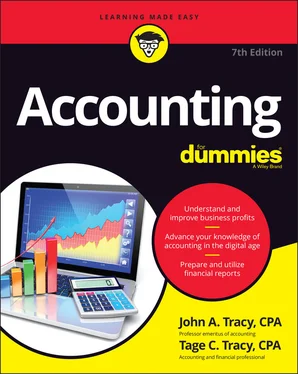John A. Tracy - Accounting For Dummies
Здесь есть возможность читать онлайн «John A. Tracy - Accounting For Dummies» — ознакомительный отрывок электронной книги совершенно бесплатно, а после прочтения отрывка купить полную версию. В некоторых случаях можно слушать аудио, скачать через торрент в формате fb2 и присутствует краткое содержание. Жанр: unrecognised, на английском языке. Описание произведения, (предисловие) а так же отзывы посетителей доступны на портале библиотеки ЛибКат.
- Название:Accounting For Dummies
- Автор:
- Жанр:
- Год:неизвестен
- ISBN:нет данных
- Рейтинг книги:3 / 5. Голосов: 1
-
Избранное:Добавить в избранное
- Отзывы:
-
Ваша оценка:
- 60
- 1
- 2
- 3
- 4
- 5
Accounting For Dummies: краткое содержание, описание и аннотация
Предлагаем к чтению аннотацию, описание, краткое содержание или предисловие (зависит от того, что написал сам автор книги «Accounting For Dummies»). Если вы не нашли необходимую информацию о книге — напишите в комментариях, мы постараемся отыскать её.
Accounting For Dummies
Accounting For Dummies — читать онлайн ознакомительный отрывок
Ниже представлен текст книги, разбитый по страницам. Система сохранения места последней прочитанной страницы, позволяет с удобством читать онлайн бесплатно книгу «Accounting For Dummies», без необходимости каждый раз заново искать на чём Вы остановились. Поставьте закладку, и сможете в любой момент перейти на страницу, на которой закончили чтение.
Интервал:
Закладка:
Meeting the balance sheet (statement of financial condition)
One type of financial statement is a “Where do we stand at the end of the period?” type of report. This is called the statement of financial condition or, more commonly, the balance sheet. The date of preparation is given in the header, or title, at the top of this financial statement. We present and explain a typical balance sheet in Chapter 2. Our purpose here is simply to present the basic content in a balance sheet.
A balance sheet summarizes the two opposite aspects of a business, which you could think of as the financial yin and yang of the business:
Assets: One side of the balance sheet lists the assets of the business, which are the economic resources owned and being used in the business. The asset values reported in the balance sheet are the amounts recorded when the assets were originally acquired — although we should mention that an asset is written down below its historical cost when the asset has suffered a loss in value. (And to complicate matters, some assets are written up to their current fair values.) Some assets have been on the books only a few weeks or a few months, so their reported historical values are current. The values for other assets, on the other hand, are their costs when they were acquired many years ago.
Sources of assets: On the other side of the balance sheet is a breakdown of where the assets came from, or their sources. Assets do not materialize out of thin air. Assets arise from three basically different sources:Creditors: Businesses borrow money in the form of interest-bearing loans that must be paid back at a later date, and they buy things on credit that are paid for later. So part of total assets can be traced to creditors, which are the liabilities of a business.Owners: Every business needs to have owners invest capital (usually money) in the business.Profit: Businesses retain part or all of their annual profits, increasing the surplus of the business. We use this term earlier in “ Thinking about where assets come from.” In most balance sheets, surplus is called retained earnings or an equivalent title. From here on, we stick with the title retained earnings. One final definition: The total of owners’ capital invested in the business and its retained earnings is labeled owners’ equity.
 Given the basic sources of assets, the financial condition of a business is condensed as follows:
Given the basic sources of assets, the financial condition of a business is condensed as follows:
$ Assets = $ Liabilities + $ Capital + $ RetainedEarnings
The dollar signs are to remind you that for each item, there’s a dollar amount that goes with it. This depiction of financial condition is referred to as the accounting equation. It stresses the point that the total amount of all assets equals the total amount of liabilities and owners’ equity. One side cannot be heavier than the other side. An imbalance signals accounting errors in recording the transactions of the business.
Looking at the accounting equation, you can see why the statement of financial condition is called the balance sheet; the equal sign means the two sides balance or are equal in total amounts.
Suppose a business reports $2.5 million total assets (without going into the details of which particular assets the business holds). Knowing that total assets are on the books at $2.5 million, we also know that the total of its liabilities, plus the capital invested by its owners, plus its retained profit adds up to $2.5 million.
 Continuing with this example, suppose that the total amount of the liabilities of the business is $1.0 million. This means that the total amount of owners’ equity in the business is $1.5 million, which equals total assets less total liabilities. This amount is also called the net worth of the business; to be more accurate, it should be called the recorded net worth of the business (which does not necessarily equal the present market value of the business). Without more information, we don’t know how much of total owners’ equity is traceable to capital invested by the owners in the business and how much is the result of profit retained in the business. But we do know that the total of these two sources of owners’ equity is $1.5 million.
Continuing with this example, suppose that the total amount of the liabilities of the business is $1.0 million. This means that the total amount of owners’ equity in the business is $1.5 million, which equals total assets less total liabilities. This amount is also called the net worth of the business; to be more accurate, it should be called the recorded net worth of the business (which does not necessarily equal the present market value of the business). Without more information, we don’t know how much of total owners’ equity is traceable to capital invested by the owners in the business and how much is the result of profit retained in the business. But we do know that the total of these two sources of owners’ equity is $1.5 million.
 Double-entry bookkeeping is a centuries-old, very clever method for keeping the accounting equation in balance. We discuss double-entry bookkeeping in Chapter 3. Basically, double-entry bookkeeping simply means that both sides of transactions are recorded. For example, if one asset goes up, another asset goes down — or, alternatively, either a liability or owners’ equity element goes up. In accounting, double-entry means two-sided, not that transactions are recorded twice.
Double-entry bookkeeping is a centuries-old, very clever method for keeping the accounting equation in balance. We discuss double-entry bookkeeping in Chapter 3. Basically, double-entry bookkeeping simply means that both sides of transactions are recorded. For example, if one asset goes up, another asset goes down — or, alternatively, either a liability or owners’ equity element goes up. In accounting, double-entry means two-sided, not that transactions are recorded twice.
A POP QUIZ
Here’s a teaser for you. If a business’s total assets equal $2.5 million and its total liabilities equal $1.0 million, we know that its total owners’ equity is $1.5 million. Question: Could the owners have invested more than $1.5 million in the business? Answer: Yes. One possibility is that the owners invested $2.5 million, but the business has so far accumulated $1.0 million of losses instead of making a profit. The accumulated loss offsets the amount invested, so the owners’ equity is only $1.5 million net of its cumulative loss of $1.0 million. The owners bear the risk that the business may be unable to make a profit. Instead of retained earnings, the business would report a $1.0 million deficit in its balance sheet.
Reporting profit and loss
 Everyone (including managers, lenders, and owners) is interested in whether the business enjoyed a profit or suffered a loss for the year. Suppose you have in your hands the balance sheet of a business showing the end of last year and the end of the year just ended. You can calculate profit or loss for the most recent year by computing the increase in retained earnings and adding the amount of distributions from profit during the year. Suppose the business’s retained earnings increased $5.0 million during the year and it paid out $2.0 million cash from profit to its owners. Therefore, its profit for the year is $7.0 million.
Everyone (including managers, lenders, and owners) is interested in whether the business enjoyed a profit or suffered a loss for the year. Suppose you have in your hands the balance sheet of a business showing the end of last year and the end of the year just ended. You can calculate profit or loss for the most recent year by computing the increase in retained earnings and adding the amount of distributions from profit during the year. Suppose the business’s retained earnings increased $5.0 million during the year and it paid out $2.0 million cash from profit to its owners. Therefore, its profit for the year is $7.0 million.
Oh, you want to know its revenue and expenses for the year — not just the profit for the year. In fact, the standard practice in financial reporting is to present a financial statement that discloses the total revenue and total expenses for the period and ends with the profit (or loss) on the bottom line of the statement. The income statement summarizes sales revenue and other income, which are offset by the expenses and losses during the period. Deducting expenses from revenue and income leads down to the well-known bottom line, which is the final net profit or loss for the period and is called net income or net loss (or some variation of these terms). Alternative titles for this financial statement are the statement of operations and the statement of earnings. Inside a business, but not in its external financial reports, the income statement is commonly called the P&L (profit and loss) report.
Читать дальшеИнтервал:
Закладка:
Похожие книги на «Accounting For Dummies»
Представляем Вашему вниманию похожие книги на «Accounting For Dummies» списком для выбора. Мы отобрали схожую по названию и смыслу литературу в надежде предоставить читателям больше вариантов отыскать новые, интересные, ещё непрочитанные произведения.
Обсуждение, отзывы о книге «Accounting For Dummies» и просто собственные мнения читателей. Оставьте ваши комментарии, напишите, что Вы думаете о произведении, его смысле или главных героях. Укажите что конкретно понравилось, а что нет, и почему Вы так считаете.












